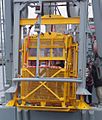Diving bell facts for kids
A diving bell is an old way to go underwater. It's like a big, upside-down cup that holds air. When you push a cup into water, air stays trapped inside, right? A diving bell works the same way. If the bell is heavy enough, it sinks. People inside can breathe the trapped air. They can even swim out for a short time and come back to the bell for more air. People have known about this idea for a long time. It became very useful in the 1600s. Today, scuba diving is more common, but diving bells are still used sometimes.
Contents
How Diving Bells Work
Diving bells help people explore underwater or do work. They are used by divers for things like fixing underwater structures or finding lost items. A large crane on a ship or dock lowers the bell into the water. The bell is heavy so it sinks. It also has weights to keep it steady.
Hoses from the surface send fresh, compressed air into the bell. This air does two important things:
- It gives the people inside fresh air to breathe. Extra air bubbles out from the bottom of the bell and goes up to the surface.
- As the bell goes deeper, the water pressure outside gets stronger. This pressure would squeeze the air inside the bell. Adding more air keeps the air space inside the bell the same size. It also replaces the air that people breathe, which would otherwise become unhealthy.
A similar idea is used in old-fashioned diving helmets. These helmets get air from the surface too. Modern divers often use surface supplied diving equipment, which is similar.
Some special underwater vehicles, called wet subs, also have a dry space for the driver's head. This works like a small diving helmet.
The idea of a diving bell is also used in underwater homes. These homes have a special opening at the bottom called a moon pool. It's like a giant diving bell that you can live in!
Wet Bells: Simple Underwater Shelters
A wet bell is a platform that takes divers down to their underwater work area. It has an air-filled space at the bottom. Divers can stand or sit there with their heads out of the water. The air inside a wet bell is always at the same pressure as the water outside. This means there are no big pressure changes.
Wet bells need to be heavy to sink. They usually have weights at the bottom to keep them stable. The base of the bell is often a metal grate or floor where divers stand. There are also places to hang the divers' air hoses and communication cables.
Other things on the bell might include:
- Tanks of emergency air.
- Racks or boxes for tools needed for the job.
Inside the bell, there's a control panel for the air supply. This panel connects to the main air hose from the surface and the emergency air tanks. It sends air to the divers' hoses. Sometimes, there are folding seats for divers to rest. This is helpful during long waits as they slowly rise to the surface.
Closed Bells: Underwater Elevators
A closed bell (or dry bell) is like a small, strong underwater room. It's lowered into the sea where divers need to work. Once it's at the right depth, the pressure inside the bell is made the same as the water outside. Then, a hatch at the bottom opens, and divers can swim out.
Because the bell needs to hold pressure, it's built very strong. It often looks like a sphere or a cylinder with rounded ends. The hatch at the bottom opens inwards. This way, the pressure inside helps keep it closed when the bell is brought back to the surface.
The bottom hatch must be big enough for a diver with all their gear to get in and out. The person inside the bell (called the bellman) can't close the hatch while a diver is outside. This is because the diver's air hose goes through the hatch. If a diver outside becomes unconscious, the bellman must be able to pull them back in and close the hatch. Then, the bell can be raised safely.
The inside of the bell is big enough for a diver and the bellman to sit. There are also places to store their air hoses neatly. Anything that isn't needed inside is put on the outside of the bell. This includes a strong frame to protect the bell. Emergency air tanks are usually stored on this frame.
The main cable that connects the bell to the surface is called the bell umbilical. It brings air, power for lights, and communication lines into the bell. Divers' individual hoses connect inside the bell. These hoses carry breathing gas, communication lines, and sometimes hot water to keep divers warm.
Some bells also have windows and a special small hatch for passing medical supplies.
How Modern Diving Bells Are Used
Diving bells are usually lowered into the water from a special frame on a ship. This frame holds a heavy weight, called a clump weight, and the bell itself. On ships designed for deep-sea diving, the bell is often lowered through a special opening in the ship's bottom, called a moon pool.
The clump weight helps guide the bell down. It hangs from cables that act like rails. The bell slides down these rails as it's lowered. This stops the bell from spinning around. If the main lifting cable breaks, the bell can float up. The guide cables help it rise straight to the surface. This makes it easier to find and recover.
The bell's main cable (umbilical) is kept separate from the divers' hoses. It's carefully unrolled from a large spool. This keeps the cable straight and prevents it from getting tangled.
History of Diving Bells
The diving bell is one of the oldest tools for working and exploring underwater. The Greek thinker Aristotle wrote about it in the 4th century BC. He said that a cauldron (a large pot) could be lowered into the water. It would hold air and let divers breathe.
In 1535, Guglielmo de Lorena made and used what many consider the first modern diving bell. Later, in 1616, Franz Kessler built an improved version.
A famous story involves Sir William Phipps in 1687. He used an upside-down container to recover a huge amount of treasure. It was from a Spanish ship that sank off the coast of Hispaniola.
In 1689, Denis Papin suggested using a pump to keep fresh air flowing into a diving bell. Engineer John Smeaton used this idea in his bell in 1789.
Early diving bells were probably used for things like collecting sponges. A diving bell also helped recover over 50 cannons from the Swedish warship Vasa. This happened soon after it sank in 1628.
In 1691, Edmond Halley (who discovered Halley's Comet) designed a diving bell. His bell could stay underwater for a long time. It had a window for looking out. To get fresh air, weighted barrels of air were sent down from the surface.
The famous artist Salvador Dalí once gave a lecture from inside a diving bell!
Diving Bells in Nature
The diving bell spider, Argyroneta aquatica, is a special spider. It lives its whole life underwater, even though it can survive on land.
Since spiders need to breathe air, this spider builds a diving bell from silk. It attaches this silk bell to an underwater plant. The spider collects air around its body using tiny hairs. It then carries this air to its silk bell to refill the air supply. This lets the spider stay in its bell for a long time. It waits there for its prey (food) to come by.
Underwater Habitats
As mentioned, the idea of a wet bell can be made much bigger. This leads to underwater habitats with a moon pool. Divers can live in these habitats for long periods in comfort. They get used to the higher pressure underwater.
By staying underwater, divers don't need to return to the surface often. This helps them avoid decompression sickness, also known as "the bends." This problem happens when nitrogen bubbles form in the blood. It can occur when divers come up too quickly from depths greater than about 6 meters (20 feet).
Diving Bells and Hyperbaric Chambers
Today, many professional diving companies use hyperbaric chambers. These are sealed diving rooms that are filled with pressurized air by a pump. They are safer because divers can be brought to the surface inside the chamber. Then, they can slowly reduce the pressure (decompress) in a safe place.
Hyperbaric chambers are often used for saturation diving and underwater rescue. Sometimes, a hyperbaric chamber is connected to a diving bell. This allows divers to move from the dry chamber into the water using the diving bell's principle.
Images for kids
-
A 16th-century painting showing Alexander the Great in a glass diving bell.
See also
 In Spanish: Campana de buceo para niños
In Spanish: Campana de buceo para niños





















